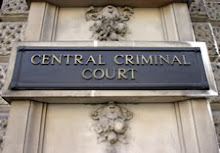London Lantern
Putting the Spotlight on London
Strange Goings-On At The Old Bailey
29/05/2002, By Candice Caster
The Old Bailey - to an American, this most famous of criminal courts conjures up images of characters straight out of Charles Dickens: from judges and barristers in their wigs and robes right down to defiant defendants in the dock. Located on the site of the old Newgate Prison, the place of many public executions, the Central Criminal Court gets its name "Old Bailey" from the street on which corner it sits.One morning in early January of this year, my husband and I travelled down Newgate Street from St. Paul's tube stop to search for the Old Bailey.
I had read in several guidebooks that an experience not to be missed while in London was attendance at a criminal trial ("the best show in town"). Remembering instructions from one of these authors, we searched for the door though which, after ringing the doorbell, we could enter, as the public is prohibited from the main entrance lobby to the courts.
A woman - a porter, I guess ( " wrong guess " T-O-B ) - appeared in the doorway, and we expressed our desire to sit in the visitor's gallery of one of the courtrooms. She let us in, and after patting us down, examining the contents of my purse, and so forth, she excitedly exclaimed, "Oh, if you have your passports, you can watch the diamond trial!"
Noticing the blank looks on our faces, she explained that this was the trial involving the attempted theft of the diamonds from the Millennium Dome. Apparently, about half a dozen men concocted a plot to take the diamonds by stealing a JCB digger, ramming it through the Dome, breaking the glass case holding the diamonds, collecting their booty and making a getaway by a boat which awaited them in the Thames.
Unbeknownst to them, however, the police found out about the plot while it was still in the planning stages and allowed them to carry it through, replacing the diamonds in the case with fakes and catching the would-be thieves in the act - at the moment they reached for the "diamonds."
Had their plans succeeded, this would have been the biggest heist in history.
So we were led into the visitor's gallery of Courtroom No. 2 by an official who, ‘sotto voce’, described the scene below: the witnesses, the members of the press, etc.
There they all were, right out of Dickens: a barrage of attorneys in black robes, white ties and wigs; the judge, in his wig and spectacles; and one of the defendants in the process of giving testimony. We settled back to watch the proceedings.
Actually, I leaned forward in an attempt to see the defendant because where he was sitting was under the visitor's gallery. I was, politely, of course, chastised by the courtroom official for hanging over the gallery. I must learn how to behave in public!
We watched as exhibits were shown. These consisted of still photos from the videotaped "evidence" since all of the action had been recorded as it took place. It was easy to follow even though we knew nothing about the case at the time.
We bought several newspapers later that afternoon in order to read about the case, but there was no coverage because this trial had been going on since November.
Though we were able to get information from the BBC website about it after we arrived home, as well as follow-up coverage and the outcome.
The big event being reported in the newspapers that day, however, was Diana's butler appearing for arraignment on an alleged robbery charge (taking things from Diana that perhaps should have ended up elsewhere) at none-other-than the Old Bailey. Somehow we missed all of that, but it just shows that you never know whom you may see there!
We listened and watched for about an hour, enjoying it thoroughly, but we were getting hungry, as it was time for lunch. We left and made our way down Fleet Street to Ye Olde Cheshire Cheese.
In this charming pub/restaurant (re-built in 1667), we sat in front of the warm coal-burning fire at a table under a plaque, which stated that this was "Charles Dickens' favourite seat." We thought this was a most appropriate way to wrap up our morning!
Candice.Caster@BTLaw.com

No comments:
Post a Comment